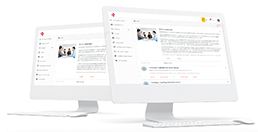Mobile Learning (mLearning): What Is It?
Sometimes simply referred to as mLearning, mobile learning is a broad term that refers to the process of learning via the internet or network using personal mobile devices such as smartphones, tablets, laptops, and digital notebooks.
Mobile learning has been around in one form or the other since the early 2000s but soared in popularity a few years ago because it allows students access to education anywhere and anytime, provided they have a mobile device.
Basics Of Mobile Learning
1. Mobile learning may be used to deliver microlearning content. It may include videos, animations, how-to guides, games, quizzes or assessments, etc.
2. Social learning elements include a discussion forum, connecting with experts and peers, chat, and knowledge sharing.
3. Offline mobile learning provides support to download the content and learn without access to the internet. You can track the learner’s progress on their mobile device and sync the data to the Learning Management System when a connection is available. Dashboards and reports are available to students, instructors, and administrators anytime.
Why Adopting mLearning Is A Smart Idea?
Mobile learning can make our lives easier in many ways, and the rate of adoption of this approach to education has skyrocketed in recent years.
Here Are The Top Benefits Of mLearning
1. Learning On The Go
One of the biggest benefits of mLearning is that people can learn from anywhere and at any time. The days where individuals love to sit behind their office desk to learn are long gone. Today’s learners want to learn without being at a particular place and at a specific time. mLearning offers instant access to relevant content.
Apart from the fact that it allows people to determine where and when to learn, mLearning also allows students to act voluntarily on their own, thus increasing their chances of being engaged in the learning process.
Even though they’re outside the confines of the classroom, students can communicate with their teachers online, participate in quizzes, and access additional videos at their convenience.
2. Supports Self-Paced Learning
Teachers are aware that students learn at different rates. Learning in a classroom puts the students under pressure to understand a particular concept or lesson within a specific duration, which often causes frustration. Mobile learning eliminates this challenge by allowing students to learn at their own pace. With mLearning, you can learn whenever you want without feeling the pressure to complete a lesson or assignment immediately.
3. Learning Is More Dynamic
No two students are the same. They don’t just learn at a pace that’s unique to them, they also learn better when they are taught using formats they are comfortable with.
For example, some students are visual learners while others are auditory learners. Classroom teaching seldom takes into account students’ learning styles or preferences, but mobile learning helps solve this problem.
Teachers can put images, presentations, audio files, or YouTube videos into their content to suit varying learning styles and reinforce what was taught in their brick and mortar classroom or virtual classroom.
In other words, mobile learning supports all types of media and eLearning features to create a dynamic and engaging experience.
4. Better Completion Rate And Higher Retention
Adopting mobile learning makes it possible to divide any lesson into smaller, more digestible bites. Usually, a large size course is not delivered through mobile apps. mLearning content is designed in a concise and straightforward format. This, in itself, holds plenty of benefits including easier understanding and retention.
For instance, many students get discouraged from learning when they see huge textbooks and the bulky coursework that must be completed. When the lesson is taught in bites via mobile learning, it helps decrease cognitive overload and decrease leaning time.
In addition, bite-sized delivery increases the likelihood of higher knowledge retention and information recall. This helps students complete any course or lesson seamlessly as well as promotes the recall of information when it is needed.
5. Encourages Collaborative Learning
Although mobile learning enables students to learn at their own pace, it also allows them to get in touch with their teacher and peers with the end goal being knowledge sharing. It encourages them to keep in touch with another so they can share ideas while also increasing the possibility of different online learning communities.
6. Cost-Effective
Another notable benefit of mobile learning is that it is cost-effective. All the teachers need to do is develop their content using a web-based authoring system and push it out to learners on their mobile devices automatically so they can learn when they’re able. It is a great way of increasing participation and engagement without breaking the bank.
7. Multi-Device Support
In other words, mLearning content supports all devices learners need and use. In a mobile learning environment, the same content can be accessed on different devices including laptops, PCs, tablets, and smartphones. Regardless of the type of device, mobile learning content looks great and is responsive on all screen sizes.
How To Best Utilize mLearning Apps For Training And Skill Development
Now that you know the benefits that mLearning offers, you may want to know how you can leverage mLearning apps for training and skill development. Here are 4 ways to do that:
1. Supplement Formal Training
If you are looking to reinforce your employees’ learning, mobile learning apps allow you to create simplified versions of your courses and deliver them in easy-to-digest formats. You can also use the mobile learning app to test their knowledge through flashcard quizzes, thus helping to refresh their memory and retain knowledge.
2. Create Course Discussions
As stated earlier, mLearning encourages collaboration between peers and experts, allowing them to share ideas, which in turn stimulates their thinking. This can further boost engagement and increase completion rates.
3. Add Gamification Features
Engagement aids learning. Adding gamification features such as rewards to your mobile learning content can help intrigue your employees and stir their desire to earn more points or badges while unconsciously encouraging them to complete the assigned learning.
4. Increased Communication With Learners
A mobile learning app simplifies the process of maintaining communication with your students as you can keep in touch with them by sending notifications about your courses or microlearning content. Also, you can attract new learners by using the app to give a sneak peek of upcoming courses.
Conclusion
For those who don’t have time to sit behind a desk in a classroom setting or those that just want to learn at their own pace, mobile learning is a blessing. Whether you are looking to exclusively train your employees or supplement their formal training, mLearning can help.
This Blog is Originally Published at eLearning Industry on September 10, 2020.





